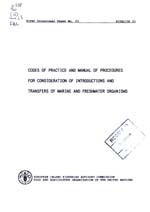
| EIFAC Occasional Paper No. 23 | EIFAC/OP 23 |
 | Codes of Practice and manual of procedures for consideration of introductions and transfers of marine and freshwater organisms |
Edited by
Gary E. Turner
The designations employed and the presentation of material in this publication do not imply the expression of any opinion whatsoever on the part of the Food and Agriculture Organization of the United Nations concerning the legal status of any country, territory, city or area or of its authorities, or concerning the delimitation of its frontiers or boundaries.
M-S 9290
All rights reserved. No part of this publication may be reproduced, stored in a retrieval system, or transmitted in any form or by any means, electronic, mechanical, photocopying or otherwise, without the prior permission of the copyright owner. Applications for such permission, with a statement of the purpose and extent of the reproduction, should be addressed to the Director. Publications Division, Food and Agriculture Organization of the United Nations. Via delle Terme di Caracalla. 00100 Rome, Italy.
PREPARATION OF THIS DOCUMENT
This report was prepared by the “Working Group on Introductions and Transfers of Marine Organisms” of the International Council for the Exploration of the Sea and by the “Working Party on Introductions” of the European Inland Fisheries Advisory Commission.
The Organization for the Improvement of Inland Fisheries (OVB) in the Netherlands kindly offered to print the report.
| Distribution | |
| - Author - EIFAC mailing list - FAO Fisheries Department - FAO Regional Fisheries Officers | For bibliographic purposes this document should be cited as follows: Turner, G.E. 1988. Codes of practice and manual of procedures for consideration of introductions and transfers of marine and freshwater organisms. EIFAC/CECPI Occasional paper No. 23 44 p. |
| This document is also published as: ICES Document No. F: 35A. |
Introductions or transfers of marine and freshwater organisms in support of aquaculture or various fishing initiatives have been increasing in numbers quite rapidly in recent years. This document, prepared as a more detailed follow-up to the “Codes of Practice” related to these movements which were prepared by the International Council for the Exploration of the Sea (ICES) and the European Inland Fisheries Advisory Commission (EIFAC), addresses some of the concerns and provides advice related to proposed introductions or transfers. Areas covered are inspection and certification, quarantine, pathology, genetics and ecology. Universal concerns in the above mentioned areas which are common to any introduction or transfer are outlined, as are those related to importations or other movements which are part of established commercial practice or those related to scientific study at research facilities. Specific examples of protocols, mainly related to controlling disease organism spread, are included as are items related to the methods of handling requests for introductions either at the national or international level.

FOOD AND AGRICULTURE ORGANIZATION OF THE UNITED NATIONS
Rome © FAO 1988
Hyperlinks to non-FAO Internet sites do not imply any official endorsement of or responsibility for the opinions, ideas, data or products presented at these locations, or guarantee the validity of the information provided. The sole purpose of links to non-FAO sites is to indicate further information available on related topics.
This electronic document has been scanned using optical character recognition (OCR) software. FAO declines all responsibility for any discrepancies that may exist between the present document and its original printed version.
2. CONSIDERATION OF REQUESTS FOR INTRODUCTIONS AND TRANSFERS AT THE NATIONAL LEVEL
3. UNIVERSAL PROTOCOL FOR NEW INTRODUCTIONS OR TRANSFERS FOR COMMERCIAL PURPOSES
3.3 Inspection and Certification
4. PROTOCOL FOR SPECIES USED IN CURRENT COMMERCIAL PRACTICE
4.1 Inspection and Certification
5. PROTOCOLS FOR SPECIES IMPORTED SOLELY FOR SCIENTIFIC STUDIES IN RESEARCH INSTITUTIONS
5.1 Procedures if stocked in open waters
APPENDICES
I Examples of specific protocols and/or special requirements for species or species groups
II Review and Decision Model For Evaluating Proposed Introductions of Aquatic Organisms.
III A. Methodology for Presenting to ICES Proposals for Introducing or Transferring Marine Organisms
B. Procedure for Consideration By EIFAC of Introduction or Transfer Requests
IV Certificate of Health and Exporters Declaration - Live Fish/Ova for Import